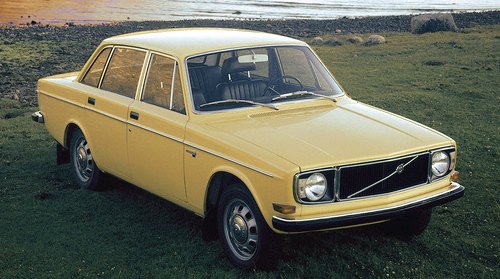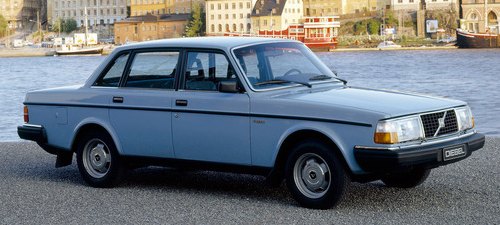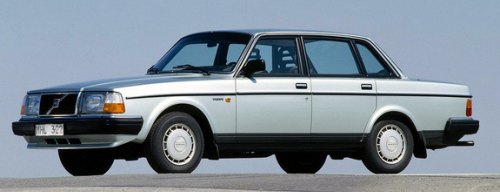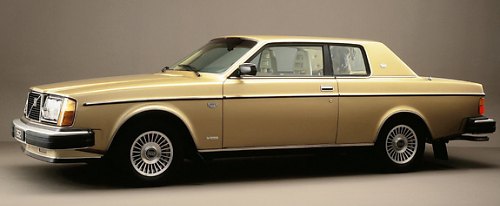 144 I have a fond memory of the Volvo 240 series because it was very popular in Hong Kong in my childhood. Strangely, its brick-like shape had little aesthetic to speak of, but it grew on you. You could feel its solidity, roominess as well as an honest character, something Mercedes, BMW, Jaguar or Saab lacked. For a quarter of a century, it was the representative Volvo, giving the Swedish brand a distinctive image. The series started as early as 1966 in the form of 144. Mechanical-wise, it was a conventional front-engined, rear-wheel-drive mid-size saloon. The double-wishbone front and live-axle rear suspensions were adapted from the preceding 122 Amazon, while the drivetrain also came from that car. However, the monocoque body was very different. It had a strong lattice protecting the passenger compartment, while the long engine compartment and boot incorporated "crumple zones", which crumpled progressively in the event of collision to absorb energy. Such a great attention to passive safety was rare in those years. Besides, it also adopted advanced safety features like 3-point seatbelts, a collapsible steering column and a fail-safe dual-channel braking system with all-round disc brakes. It established a strong safety image for Volvo. The cabin was very roomy and comfortable. Plus, it had a very powerful ventilation system to withstand the harsh Scandinavian winter.  244 Initially, the 144 was powered by a 1.8-liter pushrod engine
producing 75 hp, or 100 hp on the higher tuned 144S. Soon it was
replaced with a 2.0-liter unit with 82 hp or 100 hp (but with more
torque). The 5-bearing engine was renowned for durability. Meanwhile, a
6-cylinder version of the engine was available to a more luxurious
version called 164, which also got a classier front end design. Now you
might know that the second digit of its model number referred to the
number of cylinder. The last digit denoted the number of doors – 4 for
the saloon, 5 for estate and 2 for coupe, so the 144 was sold alongside
145 and 142.
This nomenclature carried on to the next generation, 240 series. Again there were 244, 245, 242 and 264 to choose from. Debuted in 1974, the new car retained the same shape, but it switched to square headlamps and a resized egg-crate grille to look more contemporary. The window frames became black, as was the belt line. More drastic changes could be found under the skin. The wheelbase was stretched by 40 mm; The front suspension changed to MacPherson struts; Rack and pinion steering replaced cam and roller to improve feel; The pushrod engine gave place to a new SOHC 2.1-liter unit with Bosch K-Jetronic mechanical injection, offering 123 hp hence improved performance. Mind you, no one would call it fast or describe its handling as sporty (too much roll and understeer compared with German machines), but as far as you sought after a comfortable luxury car the Volvo would never disappoint.  240 If you want faster pace, 264 would be a little better with its new PRV (PSA-Renault-Volvo) V6. However, most people were satisfied with 244, especially after the launch of the 2.3-liter, 140 hp GLT (Grand Luxe Touring). As a result, the V6 model did not last beyond 1985, whereas the four-cylinder model continued through 1993. Since 1982, Volvo simplified the nonemclature and called the car either 240 or 260 regardless of doors. I remember how that confused me – why people kept saying 240 was newer than 244? Two special versions are worth notable mentioning: 262C: special edition assembled by Bertone in Turin. The 2-door coupe got a cut-down roof and an American-style C-pillar to look dramatic. 6,622 cars were built between 1977 and 81. 240 Turbo / 244 GLT Turbo: the 2.1-liter engine got turbocharging to produce 155 hp. This was the highest performance member of all. Famously used on motor-racing and won the European Touring Car Championship in 1985. Yes, the Brick beat TWR Rover 3500, BMW 635CSi and Alfa GTV6 etc!  262C All in all, the long-lasting 140/240 series sold more than 4
million units in total. It was by far the most successful Volvo of all
time.
|